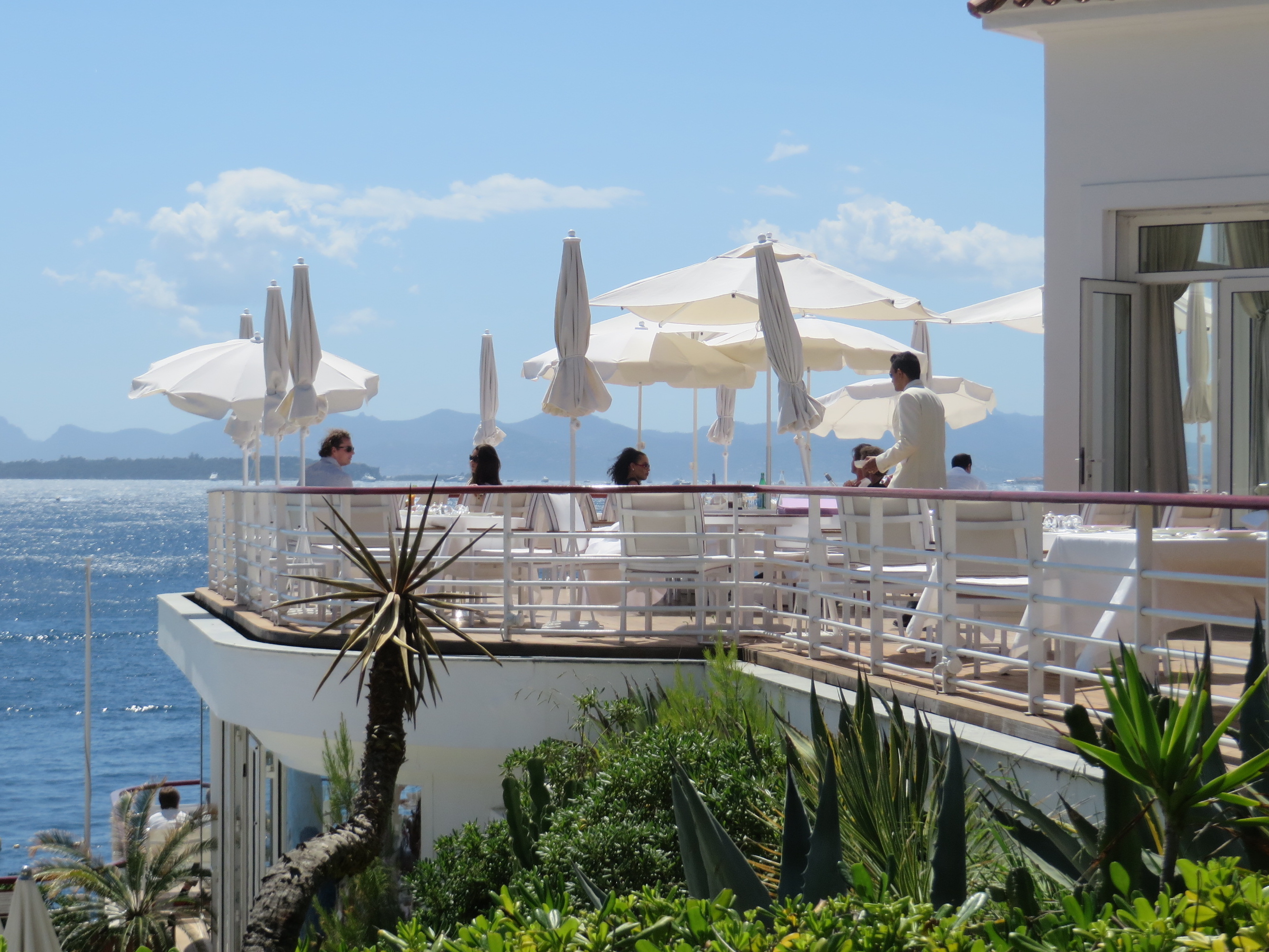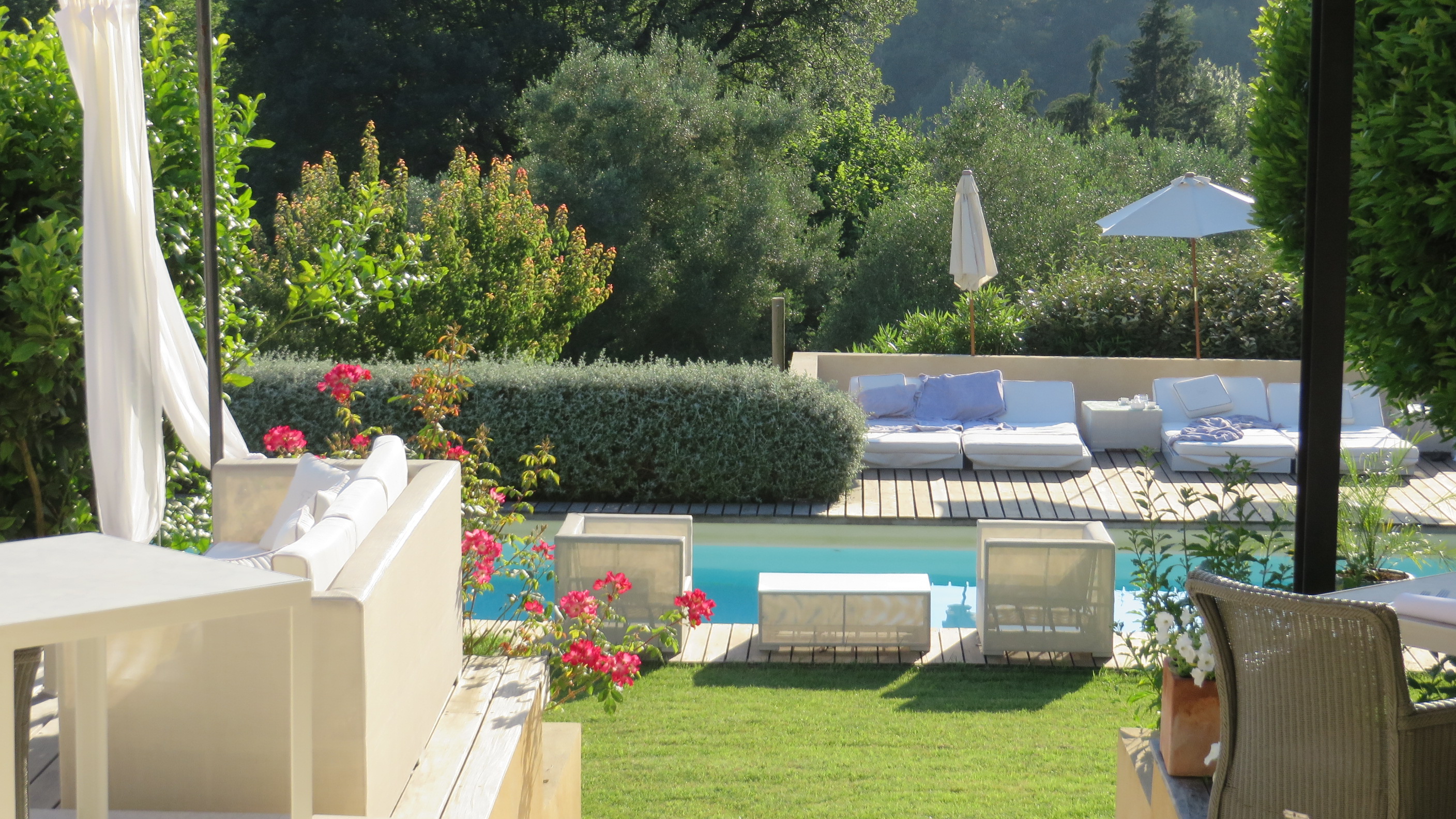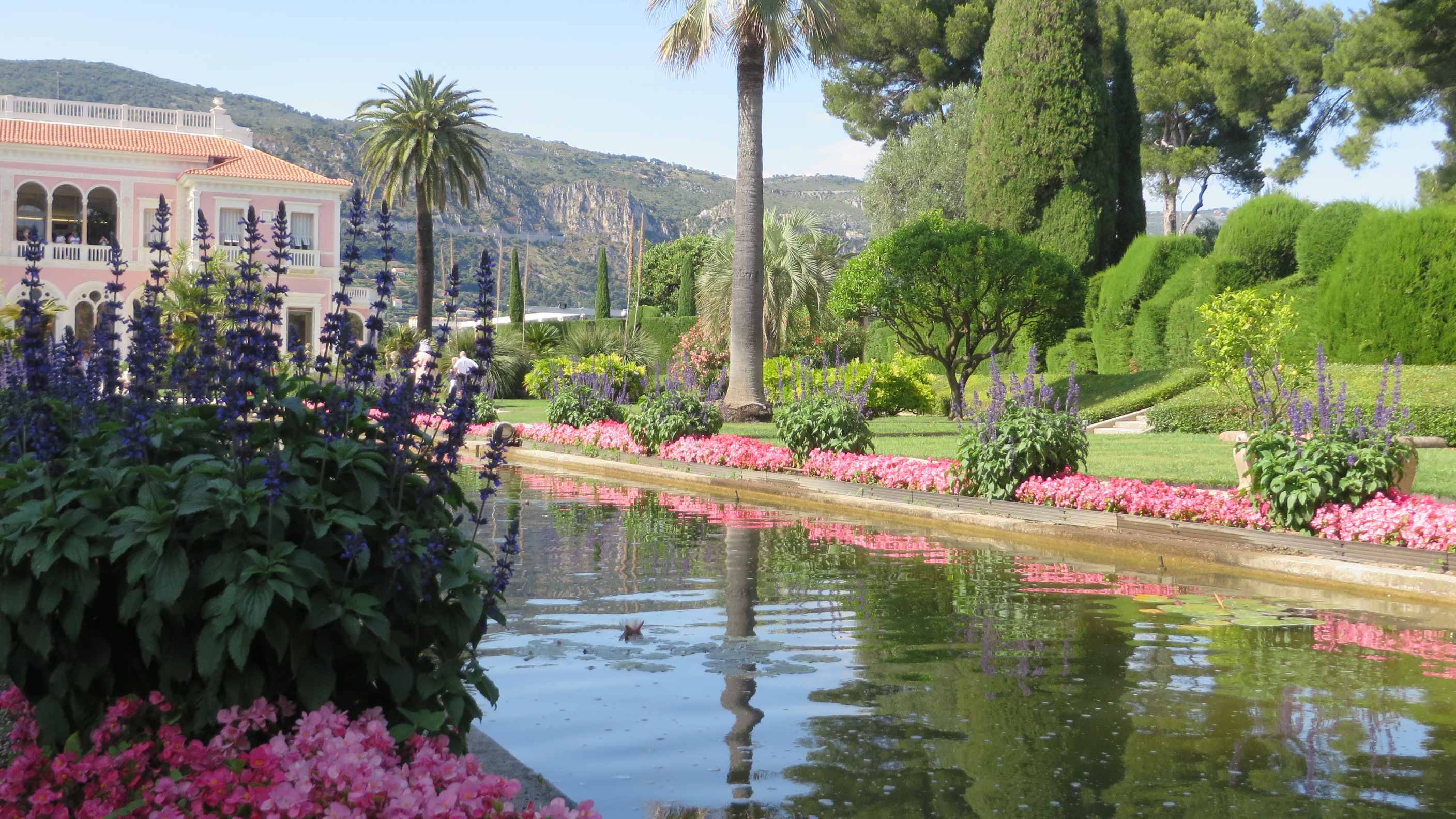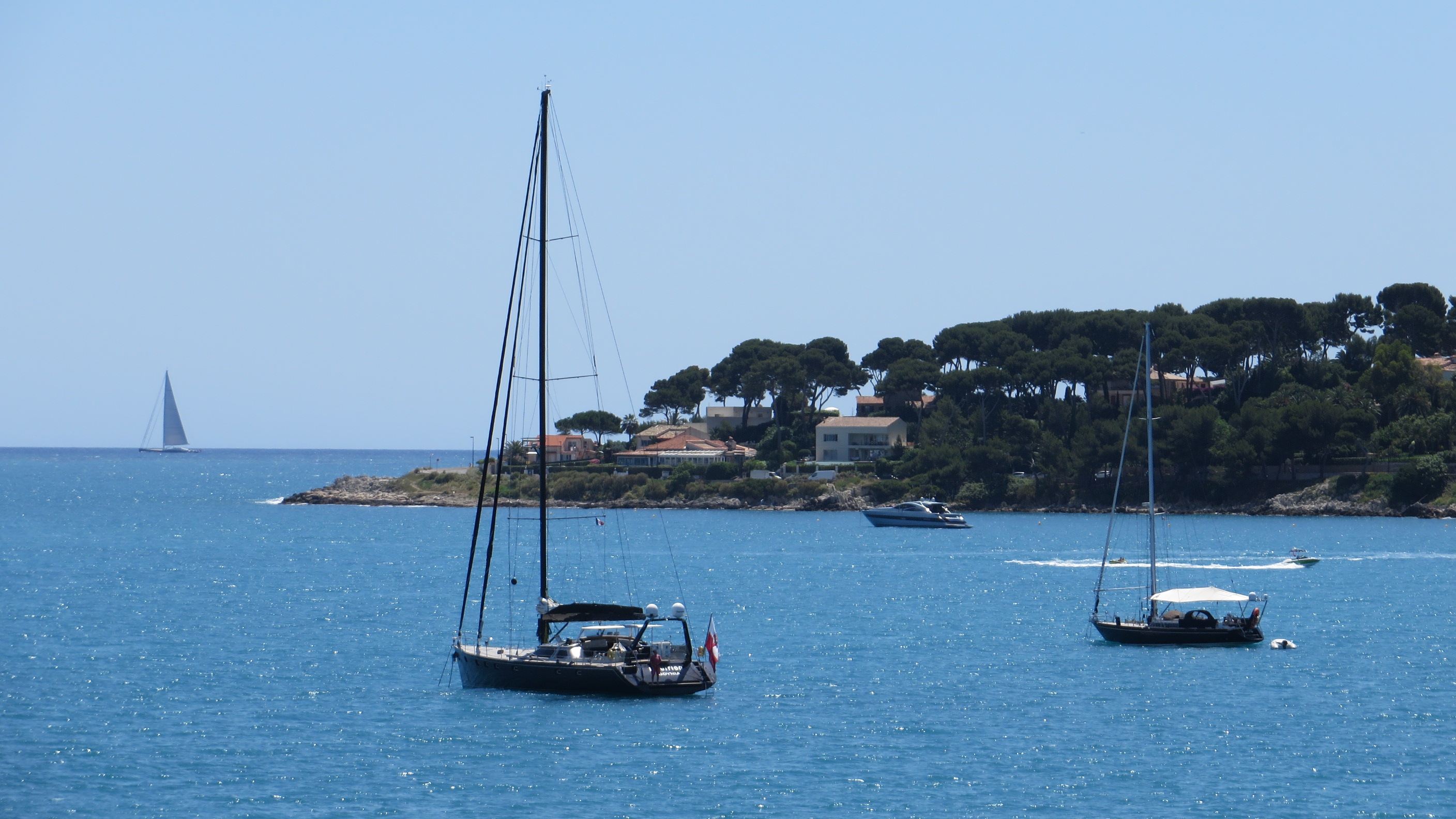(For English version please scroll down the page)
Pēc Nicas un Monako iepazīšanas (raksta 1. daļa publicēta 25. jūlija Dienā), laiks noīrēt auto. Ko tur liegties, aizsegt Dienvidfrancijas žilbinoši zilās debesis ar jumtu ir vistīrākāis grēks, tāpēc kabrioleta izvēli nenākas noželot ne mirkli (Nicas lidostas otrā termināla teritorijā bāzējas visas lielākās autonomas). Lai arī attālumi starp tuvākajām pilsētām un ciemiem ir nelieli, ar auto tos sasniegt ir nesalīdzināmi ērtāk, nekā izmantojot sabiedrisko transportu vai Dienvifrancijas dārgos un grūti “noķeramos” taksometrus.
Aptuveni trīsdesmit minūšu attālumā no Nicas, nelielā Senpoldevānsas ciemata pakājē, noslēpusies izcila pērle, nelielā viesnīca Toile Blanche (826, Chemin de Pounchouniere, Saint Paul de Vence). Sena lauku muiža, kas šodien ar mūsdienīgiem akcentiem transformēta par absolūtu miera oāzi. Toile Blanche grūti nosaukt par viesnīcu, jo šeit apmetoties, pārņem sajūta it kā jūs satiktos ar sen neredzētiem draugiem – tik personīga ir uzņemšana. Toile Blanche kodols ir trīs brāļi Nikolā, Gregorijs un Žils, kuri zem zīmola Leroy Brothers aktīvi darbojas arī modernās mākslas laukā un viņu rokraksts akcentēts īpaši efektīgajos interjera elementos – lielformāta fotogrāfijās un gleznās. Šī ir ideāla vieta, kurā izbaudīt Provansas nesteidzīgumu, ik vakaru atgriežoties atpakaļ no tuvāka vai tālāka izbrauciena.
Mākslinieku meka
Uz turpatesošo Senpoldevānsu no Toile Blanche var doties ar auto vai kājām. Neilgā pastaiga pa serpentīnveida ceļu aizvien augstāk kalnā prasa nelielu fizisko piepūli, taču atklāj pārsteidzošus skatus uz tuvāko apkārtni. Ienākot pilsētā cauri senajiem vaļņiem, jāļaujas šauro ielu labirintam – apmaldīties ir neiespējami, jo no viena nelielā ciemata gala līdz otram var aiziet desmit minūtēs. Senpoldevānsa ir savdabīgs muzejs zem klajas debess, kur ik uz soļa var uzdurties kādai no daudzajām modernās mākslas galerijām, kuru futūristiskie interjeri organiski saplūst ar viduslaika ciemata autentisko arhitektūru.
Tieši pārsteidzošais mūsdienīguma gars patīkami atšķir Senpoldevānsu no citiem senajiem ciematiem, jo laiks šeit nav iekonservēts, vēsture kalpo kā platforma mūsdienīgai attīstībai. Neizbrīna fakts, ka Senpoldevānsā bāzējas viens no skaistākajiem modernās mākslas muzejiem Eiropā Fondation Maeght, kura tapšanā bijuši iesaistīti arī Miro un Šagāls. Arhitekta Hosē Luisa Serta 1964. gadā projektētājā baltajā ēkā izstādīti Bonāra, Braka, Kandinska un citu grandu darbi. Savukārt leģendārā viesnīca La Colombe d’Or (Pl. General de Gaulle, St Paul de Vence, 06570) lepojas ar iespaidīgu Pikaso un Matisa darbu kolekcijām – savulaik dižgari par vakariņām un naktsmītni šeit norēķinājās nevis ar naudas, bet gan savu darbu palīdzību. Colombe d’Or restorāns jau sen nav tikai vieta, kurā ieturēt izcilu Provansas virtuves maltīti. Tā ir meka, kur viesi atgriežas vairāku gadu desmitu garumā, lai atkal un atkal baudītu šo vietu, apsēstos pie sava galdiņa, nemainīgi uzkodās izvēlētos svaigo dārzeņu grozu un pasūtītu glāzi rose. Un, protams, uzmestu aci Ležē gleznojuma sirreālajiem varoņiem, kas jau dekādēm nolūkojas uz restorāna dārza apmeklētājiem.
Īpašu burvību Senpoldevānsa iegūst pēc saulrieta. Ielās valda klusums, caur slēgto māksas galeriju logiem plūst intīma gaisma un tikai rets pretīmnācējs vai kaķis iztraucē pilnīgo vientulības sajūtu.
Senpoldevānsa nenoliedzami nozog fokusu no apkārtējām vietām, īpaši no Vānsas (dažus kilometrus ziemeļu virzienā no Senpoldevānsas), kas lepojas ar vaļņu nocietinātu vecpilsētu. Vānsas vēsturisko daļu vislabāk izstaigāt agri no rīta, pirms vēl šaurās ielas nav piepildījuši tūristu pūļi. Vērojot, kā kafejnīcu īpašnieki malko rīta kafiju pie savu iestāžu vēl tukšajiem galdiem, bet vietējie iepērkas nelielajos dārzeņu un zivju veikalos, rodas ilūzija par lēnāku laika ritējumu, daudz nesteidzīgāku un mierīgāku. Vānsa īpaši tuva bija Anri Matisam, kura darbi rotā nelielās kapelas Chapelle du Rosaire sienas.
Rivjēras klasika
Visi ceļi ved gar jūru. Vismaz ainaviskākie, noteikti. Franču Rivjēras rietumu virzienā Bord de mer ceļš izvijas cauri tādiem pieturpunktiem kā Antibas, Antibu zemesrags (Cap d’Antibes) un Kannas. Tas ļauj baudīt ne vien neizmirstamus skatus, bet pa ceļam arī piestāt kādā no daudzajām pludmalēm un izbaudīt atsvaidzinošu peldi. Antibu sejas neatņemama sastāvdaļa ir osta, jo tieši te koncentrējas lielākais jahtu skaits visā Rivjērā, ļaujot lepoties ar Vidusjūras burāšanas centra statusu. Lēna pastaiga pa garo jahtu piestātni ļauj pielāgoties nesteidzīgam dzivesstilam, īpaši vērojot tos jahtu īpašniekus, kas siltajā periodā izvēlas savu peldlīdzekli padarīt par otrajām mājām, cietzemi nomainot pret viļņu šūpošanos. Ceļš gar jahtu piestātni aizved līdz pat vecpilsētas mūriem un pēc brīža, līdz pat Pikaso muzejam. Dižā spāņu gleznotāja vārds cieši savijies ar Rivjēru – uzturoties Château Grimaldi, kurā šobrīd atrodas mākslinieka muzejs, viņš guva iedvesmu tādiem darbiem kā Kaza un La Joie de Vivre.
Džeza laikmeta gara atskaņas joprojām jūtamas Cap d’Antibes pussalā. Lai arī laiks, kad te bohēmiskām dzīrēm nodevās Ficdžeraldu pāris ir palicis skaistās pagātnes atmiņās, šis joprojām ir viens no greznā dzīvesveida epicentriem. Zemesraga pašā smailē esošā Hotel du Cap Eden Roc (Boulevard John F Kennedy 06601, Antibes) ir iekārotākā zvaigžņu apmešanās vieta. Viesnīcas viesu jeb Zelta grāmata burtiski plīst no A saraksta autogrāfiem. Marlēna Dītriha, Elizabete Teilore, Klints Īstvuds, Miks Džegers, Breds Pits, Odrija Tatū, Monika Belluči, Kolins Fērts, Leonardo Di Kaprio, Karls Lāgerfelds un neskaitāmi citi. Kannu kinofestivāla laikā eleganatā luksusviesnīca, kas pirms pāris gadiem piedzīvoja iespaidīgu 45 miljonus eiro vērtu renovāciju, čum un mudž no spīdekļiem. Pat ja šeit nenakšņojat, atbildi uz jautājumu “Kāpēc šī viesnīca ir tik īpaša?” viegli var iegūt ieturot maltīti tās restorānā Eden Roc Restaurant. Ēdiena izpildījums, viesmīlības augstākā pilotāža un nepārspējamais skats pāri tirkīzzilajam ūdenim uz tālumā esošajām Lerensu salām (Îles de Lérins) tiešām liek paskatīties uz dzīvi rožainā gaismā. Absolūta perfekcija.
Hotel du Cap Eden Roc pēcgarša saglabājas ilgi un, iespējams, labākais veids kā to paildzināt, ir vakarpusē doties uz Kannām un pasūtīt glāzi saldi rūgtenā French 75. Laba izvēle ir jauneklīgā viesnīca Hotel 3.14 Cannes (5, rue François Einesy 06400 Cannes), no kuras sestā stāva bāra paveras skats uz vienu no Kannu simboliem – majestātisko Carlton ēku un jūru.
Meklējot dārgakmeņus
Atsevišķu dienu vai pat vairākas vērts veltīt iepazīstot nelielās, bet ļoti skaistās vietas Franču Rivjēras austrumos. Moyenne Corniche gleznainais autoceļš vilina ik pēc brīža apstāties kādā no ierīkotajiem skatpunktiem un vērties brīnišķīgajā Vidusjūras horizontā. Kalnu ieskautā piekrastes pilsēta Vilfranša (Villefranche sur Mer), veroties no tālāka skatpunkta, atgādina amfiteātri.
Vēsturiski kalpojusi kā ostas pilsēta, arī šodien tās ieliņās var uzķert zvejnieku ciemata atmosfēru. Vajag tikai sekot intuīcijai un tā jau pēc brīža aizvedīs nost no cilvēku piesātinātakajām ielām krastmalā uz pavisam klusiem pagalmiem, kur pilnīgā harmonijā dzirdama tikai putnu čivināšana un augu lapu čaboņa vējā. Pilsētas reljefs izveidojies tā, lai kāpjot aizvien augstāk, pavērtos aizvien iespaidīgāks skats uz dabisko ostu. Kura, starp citu, ir tik dziļa, lai vajadzības gadījumā tajā varētu izvietot pat veselu floti. Pārsteigums ir pavisam īsā, taču dažādu sajūtu buķeti uzjundošā rue Obscure (Tumšā iela). Paslēpusies zem velvēm, tā atgādina nelielu pazemes eju un pa to pārvietojoties, dzirdama tikai spokaina soļu atbalss. Otrā pasaules karā tā izglāba daudzu iedzīvotāju dzīvības, jo uzlidojumu laikā sniedza drošāku patvērumu par neaizsargātajiem namiem.
Visā Vilfranšas garumā stiepjas liedags, tāpēc šī ir ideāla vieta pēcpusdienas peldei. Padomāts arī par brīvdabas dušām, kurās pēc peldes noskalot krietni sāļo Vidusjūras ūdeni.
Tālāk ceļš vijas aizvien augstāk kalnos, kur atrodas piekrastes augstākais ciemats Ēza (Eze). Tās lielākais trumpis ir atrašānās vieta – reibinoši augstu uz klints smailes. Dienas vidū pilsētas šaurās ielas atgādina skudrupūzini, kuras ejas piepildījuši tūristi, tāpēc lielākais baudījums ir tieši iespaidīgais ceļu serpentīns līdz Ēzai, kas atgādina lēnus amerikāņu kalniņus ar dramatiskām ainavām.
Savukārt Ferā zemesraga pussala (Cap Ferrat) iemieso Rivjēras izsmalcinātās greznības esenci. Līdzās neprātīgi krāšņām šodienas miljardieru villām (miljonāri tās vēl tikai iekāro), pussala glabā pagātnes noslīpētāko dārgakmeni. Villa Ephrussi de Rothschild, leģendārajam Rotšildu klanam piederošais ekstravagantais savrupnams ar greznajiem, tematiskajiem dārziem, aizrauj elpu. Īstens mākslas darbs, kuru baronese Beatrise Rotšilda realizēja XX gadsimta sākumā. Rozā un gaišzilā salikums šeit iemiesots līdz perfekcijai – villas maigi rozīgais tonis gleznaini saderas ar Vidusjūras toni.
Sajūtas paspilgtina ar pulksteņmeistara precizitāti iekārtotie dārzi – no Ķīnas austrumniecisko akcentu piesātinātajiem līdz Provansas lavandu klātajiem. Baudot dabas un cilvēka mākslas simbiozi, šeit var aizmirst par laiku – gan to, ko tobrīd uzrāda pulkstenis, gan plašākā mērogā – par laiku, kurā dzīvojam.
Francijas Rivjēra sniedz neaizmirstamas emocijas. Laiks paskrien vēja spārniem un, lidmašīnai atraujoties no skrejceļa, pārņem patīkama mazuma pēcgarša. Tieši tāda, kā pēc glāzes Bollinger. Neliela eiforija, kad baudīta izcilība, un leģendārais rivjēras šarms – tas joprojām ir tepat. Raisot vēlmi atgriezties, lai šo šedevru turpinātu šķetināt tālāk, ciemu pa ciemam, ielu pa ielai.
A Spike of Style
After getting familiar with Nice and Monaco, it’s time to rent a car. No dodging that covering up the dazzling blue sky of Southern France with a roof is a sin, that’s why one won’t regret the choice of a convertible for even a moment (all the biggest car rental companies are located at the second terminal of the Nice Airport). Although the distance between the nearby towns and villages is short, with a car it is much more convenient to reach them than by using public transportation or Southern France’s expensive, and seemingly ‘unhailable’, taxis.
About thirty minutes outside of Nice, at the foot of the small village Saint Paul de Vence, an excellent gem is hidden, the small hotel Toile Blanche (826 Chemin de Pounchouniere, Saint Paul de Vence). An old rural mansion which, with modern accents, today has been transformed into an oasis of absolute peace. Toile Blanche is hard to call a hotel because when staying here, a feeling seizes you as if you were meeting up with long lost friends – so personal is the reception. Toile Blanche’s core consists of three brothers, Nicolas, Gregory and Gilles who, under the name Leroy Brothers, are also active in the field of contemporary art, and their manner is accentuated in particularly effective interior elements – large-format photographs and paintings. This is an ideal place to enjoy the tranquillity of Provence, every evening returning from a nearby, or further away, daytrip.
Artists’ mecca
To the adjacent Saint Paul de Vence, it is possible to go by car or foot from Toile Blanche. A short stroll through the serpentine road higher up in the mountain requires a little physical effort, but reveals amazing views of the surroundings. When you enter the city through the ancient ramparts, drift through the maze of narrow streets – it is impossible to get lost, because from one end of the small village to the other can be travelled in ten minutes. Saint Paul de Vence is a unique museum in the open air, where with each step it is possible to stumble across one of the many modern art galleries, where futuristic interiors organically blend with the medieval village’s authentic architecture. Exactly this surprising spirit of modernity distinguishes Saint Paul de Vence from other ancient villages, because time is not bottled up there, history serves as a platform for modern development. It’s unsurprising to discover that one of the most beautiful modern art museums in Europe Fondation Maeght is based in Saint Paul de Vence, in the making of which Miro and Chagall were involved. Architect Josepp Lluis Sert’s 1964 designed white building exhibits the works of Bonnard, Braque, Kandinsky, and other grandiosos. But the legendary hotel La Colombe d’Or (Pl. General de Gaulle, St Paul de Vence, 06570) takes pride in an impressive collection of works by Picasso and Matisse – once, such grandiosos did not pay with money for dinner and accommodation, but with their work.
For quite a while, Colombe d’Or restaurant has not just been a place to enjoy an excellent meal of Provencal cuisine. It is a mecca, where guests return throughout the decades to again and again enjoy specifically this place, sit down at their table, unrelentingly choosing a basket of fresh vegetables for a snack, and order a glass of rose. And, of course, glance at the surreal characters of Leger paintings that have been looking at the restaurant’s garden visitors for decades.
Saint Paul de Vence obtains a special magic after sunset. A quietness prevails in the streets, through the windows of the closed art galleries, intimate light flows, and only an occasional passerby or cat disturbs the sense of complete loneliness.
Saint Paul de Vence undeniably steals the focus from the surrounding areas, especially from Vence (a few kilometres north of Saint Paul de Vence), which takes pride in an old city fortified by ramparts. Vence’s historical area is best to walk through in the early morning, before the narrow streets have been filled by the crowds of tourists. Observing how the cafe owners sip their morning coffee at their establishments’ still empty tables, while the locals shop in the small vegetable and fish shops, an illusion appears of a slower flow of time, a lot less hurried, and more relaxed. Vence was particularly close to Henri Matisse, whose works decorate the walls of the small Chapelle du Rosaire.
The classics of Riviera
All roads travel along the sea. At least the most picturesque, certainly. In French Riviera, the western Bord de mer road winds through such stops as Antibes, Antibes Cape (Cap d’Antibes) and Cannes. It not only allows you to enjoy unforgettable views, but along the way to stop at one of the many beaches and enjoy a refreshing swim. An integral part of the face of Antibes is the port, because right there the largest number of yachts concentrate in the whole of the Riviera, allowing it to take pride in its status as a Mediterranean sailing hub. A slow stroll along the long marina allows you to become acquainted with the leisurely lifestyle, especially watching those yacht owners who prefer to make their water transport a second home in the warm season, thus exchanging the mainland for the whims of the waves. The path along the marina takes you up to the old city walls and after a moment, to the Picasso Museum. The great Spanish painter’s name is firmly tied to the Riviera – staying in Château Grimaldi, now housing a Museum dedicated to the artist, he was inspired for such works as Goat and La Joie de Vivre.
Repercussions of the Jazz Age spirit are still felt in the Cap d’Antibes peninsula. Though the time when the Fitzgerald couple indulged themselves in bohemian feasts here has remained in beautiful memories of the past, this is still one of the epicentres of a luxurious lifestyle. In the cape’s very spike, Hotel du Cap Eden Roc (Boulevard John F Kennedy 06601, Antibes) is the most desired star accommodation. The hotel’s guest, or Golden, book literally bursts with A-list autographs. Marlene Dietrich, Elizabeth Taylor, Clint Eastwood, Mick Jagger, Brad Pitt, Audrey Tautou, Monica Bellucci, Colin Firth, Leonardo DiCaprio, Karl Lagerfeld and countless others. During the Cannes Film Festival, the elegant luxury hotel, which a few years ago experienced an impressive 45 million Euro renovation, is swarming with luminaries. Even if you don’t stay here overnight, the answer to the question “Why is this hotel so special?” can be easily acquired by having a meal in its restaurant Eden Roc Restaurant. The food execution, hospitality’s acrobatics, and the unsurpassed view over the turquoise water of the distant Lerins Islands (Îles de Lérins) really makes you look at life in a rosy light. Absolute perfection.
Hotel du Cap Eden Roc’s aftertaste remains for a long time, and probably the best way how to lengthen it, is, in the evening, to go to Cannes and order a glass of sweetly bitter French 75. A good choice is the youthful hotel Hotel 3.14 Cannes (5, rue François Einesy 06400 Cannes), from which a sixth-floor bar opens up a view over one of the symbols of Cannes – the majestic Carlton building and the sea.
Looking for gems
A separate day, or even a couple, is worth spending becoming acquainted with the small, but very beautiful, places on the east of the French Riviera. The Moyenne Corniche scenic highway often tempts you to stop in one of the observation areas and gaze at the wonderful Mediterranean horizon. Surrounded by mountains, the coastal city of Villefranche sur Mer, looking from a further observation area, resembles an amphitheatre. Historically, it served as a port city, also today the atmosphere of a fishing village can be found in its streets. It is only necessary to follow intuition, and in a short moment it will take you away from the people saturated streets of the waterfront to the completely quiet courtyards where, in perfect harmony, only the chirping birds and the rustling of leaves in the wind can be heard. The city’s terrain has formed in such way that climbing ever higher, an ever more impressive view opens of the natural harbour. Which, by the way, is so deep, that, if necessary, could accommodate a whole fleet. A surprise is the short, but a bouquet of different senses, releasing from rue Obscure (Dark Street). Hidden away under the arches, it resembles a small underground passage, and moving through it, you can only hear an echo of spooky steps. In World War II it saved the lives of many people because in an air attack, it provided a safer haven than the vulnerable houses.
All along the Villefranche stretches a beach shore, and that’s why it is an ideal place for an afternoon swim. They’ve thought of open-air showers to rinse off the quite salty water of the Mediterranean after swimming.
Further along, the route winds ever higher into the mountains, where the highest coastal village Eze is located. Its biggest trump card is its location – dizzyingly high on a rock spire. In the middle of the day the city’s narrow streets resemble an anthill, whose tunnels have been filled by tourists, that’s why the greatest pleasure is, particularly, the impressive serpentine road to Eze, resembling a slow roller coaster with dramatic landscapes.
But the peninsula of the Cap Ferrat embodies the essence of the Riviera’s exquisite luxury. Next to today’s billionaires madly gorgeous villas (millionaires still only desire them) the peninsula stores history’s most polished gem. Villa Ephrussi de Rothschild, owned by the legendary Rothschild clan, this extravagant mansion with luxurious, thematic gardens, is breathtaking. A true work of art which Baroness Beatrice Rothschild accomplished at the beginning of the twentieth century. The pink and light blue combination has been reincarnated to perfection – the villas gentle pink tone artistically fits with the Mediterranean tone. Senses are highlighted by a watchmaker’s precision designed gardens – from those infused by a Chinese Oriental accent to those covered in Provence lavender. Enjoying a symbiosis of nature and human art, time can be forgotten about here – both the one that is at that moment showed by the clock, and on a larger scale – the time in which we live.
The French Riviera offers unforgettable emotions. Time flies with the wings of the wind, and when the airplane takes off the runway, a pleasant scant aftertaste takes over. Precisely the same as after a glass of Bollinger. A slight euphoria, when excellence has been enjoyed, and the legendary Riviera glamour – it’s still here. Raising the desire to come back to continue untwisting this masterpiece village by village, street by street.








